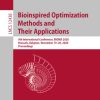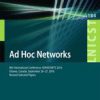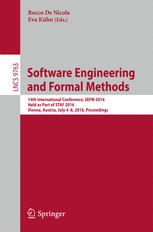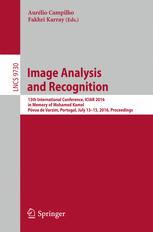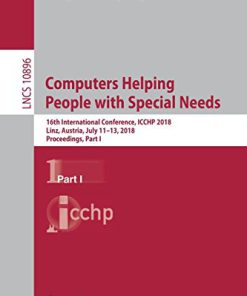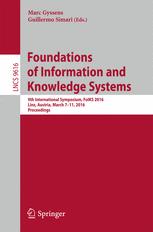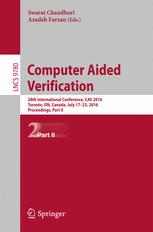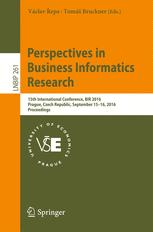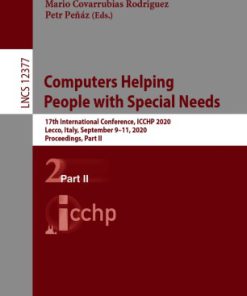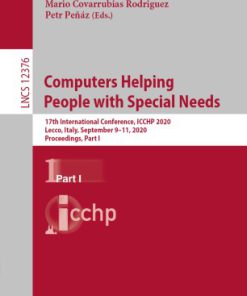Computers Helping People with Special Needs 15th International Conference ICCHP 2016 Linz Austria July 13 15 2016 Proceedings Part II 1st Edition by Klaus Miesenberger 3319412663 9783319412665
$50.00 Original price was: $50.00.$25.00Current price is: $25.00.
Computers Helping People with Special Needs 15th International Conference ICCHP 2016 Linz Austria July 13 15 2016 Proceedings Part II 1st Edition by Klaus Miesenberger – Ebook PDF Instant Download/DeliveryISBN: 3319412663, 9783319412665
Full download Computers Helping People with Special Needs 15th International Conference ICCHP 2016 Linz Austria July 13 15 2016 Proceedings Part II 1st after payment.
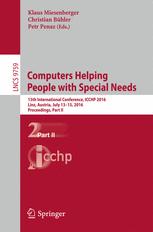
Product details:
ISBN-10 : 3319412663
ISBN-13 : 9783319412665
Author: Klaus Miesenberger
The two volume set LNCS 9758 and 9759, constitutes the refereed proceedings of the 15th International Conference on Computers Helping People with Special Needs, ICCHP 2015, held in Linz, Austria, in July 2016. The 115 revised full papers and 48 short papers presented were carefully reviewed and selected from 239 submissions. The papers included in the second volume are organized in the following topics: environmental sensing technologies for visual impairments; tactile graphics and models for blind people and recognition of shapes by touch; tactile maps and map data for orientation and mobility; mobility support for blind and partially sighted people; the use of mobile devices by individuals with special needs as an assistive tool; mobility support for people with motor and cognitive disabilities; towards e-inclusion for people with intellectual disabilities; At and inclusion of people with autism or dyslexia; AT and inclusion of deaf and hard of hearing people; accessible computer input; AT and rehabilitation for people with motor and mobility disabilities; HCI, AT and ICT for blind and partially sighted people.
Computers Helping People with Special Needs 15th International Conference ICCHP 2016 Linz Austria July 13 15 2016 Proceedings Part II 1st Table of contents:
1. Environmental Sensing Technologies for Visual Impairment
Part Frontmatter
Ball Course Detection Function for the Blind Bowling Support System Using a Depth Sensor
Catching the Right Bus – Improvement of Vehicle Communication with Bluetooth Low Energy for Visually Impaired and Blind People
Navi Rando
Scene Text Detection and Tracking for Wearable Text-to-Speech Translation Camera
Zebra Crossing Detection from Aerial Imagery Across Countries
Sound of Vision – 3D Scene Reconstruction from Stereo Vision in an Electronic Travel Aid for the Visually Impaired
Experiments with a Public Transit Assistant for Blind Passengers
2. Tactile Graphics and Models for Blind People and Recognition of Shapes by Touch
Electromagnetic Microactuator-Array Based Virtual Tactile Display
Empowering Low-Vision Rehabilitation Professionals with “Do-It-Yourself” Methods
Expansion Characteristic of Tactile Symbols on Swell Paper
Tactile Identification of Embossed Raised Lines and Raised Squares with Variable Dot Elevation by Persons Who Are Blind
Early Stimulation with Tactile Devices of Visually Impaired Children
Experimenting with Tactile Sense and Kinesthetic Sense Assisting System for Blind Education
Locating Widgets in Different Tactile Information Visualizations
A Concept for Re-useable Interactive Tactile Reliefs
Three-Dimensional Models of Earth for Tactile Learning
3. Tactile Maps and Map Data for Orientation and Mobility
Augmented Reality Tactile Map with Hand Gesture Recognition
Blind Friendly Maps
BlindWeb Maps – An Interactive Web Service for the Selection and Generation of Personalized Audio-Tactile Maps
CapMaps
Empirical Study on Quality and Effectiveness of Tactile Maps Using HaptOSM System
Specification of Symbols Used in Audio-Tactile Maps for Individuals with Blindness
User Requirements Regarding Information Included in Audio-Tactile Maps for Individuals with Blindness
4. Mobility Support for Blind and Partially Sighted People
Obstacle Detection and Avoidance for the Visually Impaired in Indoors Environments Using Google’s Project Tango Device
System Supporting Independent Walking of the Visually Impaired
Path Planning for a Universal Indoor Navigation System
Supporting Pedestrians with Visual Impairment During Road Crossing: A Mobile Application for Traffic Lights Detection
Sound of Vision – Spatial Audio Output and Sonification Approaches
5. The Use of Mobile Devices by Individuals with Special Needs as an Assistive Tool
Part Frontmatter
Parents’ and Teachers’ Perspectives on Using IPads with Students with Developmental Disabilities
The iPad Helping Preschool Children with Disabilities in Inclusive Classrooms
Easy Access to Social Media: Introducing the Mediata-App
A Tool to Improve Visual Attention and the Acquisition of Meaning for Low-Functioning People
6. Mobility Support for People with Motor and Cognitive Disabilities
A Mobile Travel Companion Based on Open Accessibility Data
Mobility Support for People with Dementia
Community Engagement Strategies for Crowdsourcing Accessibility Information
Sharing Real-World Accessibility Conditions Using a Smartphone Application by a Volunteer Group
Development and Evaluation of Navigation System with Voice and Vibration Output Specialized for Persons with Higher Brain Dysfunction
SIMON: Integration of ICT Solutions for Mobility and Parking
7. Towards e-Inclusion for People with Intellectual Disabilities
Part Frontmatter
Criteria of Barrier-Free Websites for the Vocational Participation of People with Cognitive Disabilities. An Expert Survey Within the Project “Online-Dabei”
Easy Reader – or the Importance of Being Understood
Potentials of Digital Technology for Participation of Special Needs Children in Kindergarten
Reordering Symbols: A Step Towards a Symbol to Arabic Text Translator
SAMi: An Accessible Web Application Solution for Video Search for People with Intellectual Disabilities
Target Group Questionnaire in the “ISG for Competence” Project
The Development and Evaluation of an Assistance System for Manual Order Picking – Called Pick-by-Projection – with Employees with Cognitive Disabilities
The Use and Impact of an Assistance System for Supporting Participation in Employment for Individuals with Cognitive Disabilities
8. AT and Inclusion of People with Autism or Dyslexia
Internal Validity in Experiments for Typefaces for People with Dyslexia
Characterization of Programmers with Dyslexia
What Technology for Autism Needs to be Invented? Idea Generation from the Autism Community via the ASCmeI.T. App
Using Mind Mapping Software to Initiate Writing and Organizing Ideas for Students with SLD and ADHD
Data Quality as a Bottleneck in Developing a Social-Serious-Game-Based Multi-modal System for Early Screening for ‘High Functioning’ Cases of Autism Spectrum Condition
Interpersonal Distance and Face-to-face Behavior During Therapeutic Activities for Children with ASD
9. AT and Inclusion of Deaf and Hard of Hearing People
Support System for Lecture Captioning Using Keyword Detection by Automatic Speech Recognition
Compensating Cocktail Party Noise with Binaural Spatial Segregation on a Novel Device Targeting Partial Hearing Loss
CoUnSiL: Collaborative Universe for Remote Interpreting of Sign Language in Higher Education
Classifiers in Arab Gloss Annotation System for Arabic Sign Language
Image-Based Approach for Generating Facial Expressions
Developing eLecture Materials for Hearing Impaired Students and Researchers: Designing Multiple-Video Programs and Usability Assessment
Effect of Vibration on Listening Sound for a Person with Hearing Loss
Designing a Collaborative Interaction Experience for a Puppet Show System for Hearing-Impaired Children
SingleScreenFocus for Deaf and Hard of Hearing Students
A Web Application for Geolocalized Signs in Synthesized Swiss German Sign Language
10. Accessible Computer Input
Evaluation of a Mobile Head-Tracker Interface for Accessibility
Replacement of the Standard Computer Keyboard and Mouse by Eye Blinks
SWIFT: A Short Word Solution for Fast Typing
An Empirical Evaluation of MoonTouch: A Soft Keyboard for Visually Impaired People
Zoning-Based Gesture Recognition to Enable a Mobile Lorm Trainer
HandiMathKey: Mathematical Keyboard for Disabled Person
A Study of an Intention Communication Assisting System Using Eye Movement
A Review of Computer-Based Gesture Interaction Methods for Supporting Disabled People with Special Needs
Optimizing Vocabulary Modeling for Dysarthric Speech Recognition
Comparison of Two Methods to Control the Mouse Using a Keypad
11. AT and Rehabilitation for People with Motor and Mobility Disabilities
Kalman-Based Approach to Bladder Volume Estimation for People with Neurogenic Dysfunction of the Urinary Bladder
Sound Feedback Assessment for Upper Limb Rehabilitation Using a Multimodal Guidance System
Personal Mobility Vehicle for Assisting Short-Range Transportation
Multimodal Sequential Modeling and Recognition of Human Activities
Android Games for Developing Fine Coordination of Movement Skills
12. HCI, AT and ICT for Blind and Partially Sighted People
Extending the Technology Enhanced Accessible Interaction Framework Method for Thai Visually Impaired People
Types of Problems Elicited by Verbal Protocols for Blind and Sighted Participants
Multimodal Attention Stimulator
Assessing Braille Input Efficiency on Mobile Devices
Smart Glasses for the Visually Impaired People
EasyTrans: Accessible Translation System for Blind Translators
An Accessible Environment to Integrate Blind Participants into Brainstorming Sessions
Elements of Adaptation in Ambient User Interfaces
Erratum to: Experimenting with Tactile Sense and Kinesthetic Sense Assisting System for Blind Educ
People also search for Computers Helping People with Special Needs 15th International Conference ICCHP 2016 Linz Austria July 13 15 2016 Proceedings Part II 1st:
computers for disabled users
use of assistive technology for persons with disabilities
computers for special needs students
computer lessons for special needs students
computer for special needs child
Tags: Computers, Special Needs, International Conference, Austria July, Klaus Miesenberger
You may also like…
Computers - Computer Science


